#literal edition
Explore tagged Tumblr posts
Text
Live footage of me suspending my disbelief and trying to figure out what symbolism Vicky is aiming for while he talks about using human feces to fertilize fields:

#Vicky. Vicky. Vicky there is a Very Good Reason everyone knows not to use human poop to grow food.#it's called Hep A Vicky#it's cholera-flavored Vicky#People will DIE Vicky#les mis#shitposting through les mis#literal edition#shitposting @ me#also more literal than usual#sewer digression#parisian sewer system#parisian sewage system
17 notes
·
View notes
Text

13K notes
·
View notes
Text
idk why ppl think megan is faking liking anime she was so right incels mad she’s a weeb and a baddie
#leave her aloneeeee#literally living her best life I love seeing all her little cosplays#EDIT: its important to recognize megan faces much more criticism and skepticism because she is black and also a woman!
14K notes
·
View notes
Text
when making a character, u have to ask urself:
are they bloody?
will they ever be bloody?
is it their blood or somebody elses blood theyre covered in?
why are they bloody?
how drenched in blood are they going to be from a scale of 1-10, with 1 being ''barely drenched'' and 10 being ''so covered we shld ask where there ISNT any blood on them''?
#edit: SHUT UP ABT ''HAVE U WORN WIGS'' ITS NOT FUNNY ANYMORE /SRS#this is literally nothing. anyways <3#haha make me shut up challenge#1k+#heritage noticed#10k+
35K notes
·
View notes
Text
having talented friends is so wild!!!!!! like. YOU!!!!!!!!!! YOU made THAT. YOU DID THAT?!?!?!?! YOU created!!!! THAT!!!!!!!!!!! WOAH!!!!!! praise!!!!!!!! praise for one thousand years!!!!!!!!!!!!!!!!!!!!!!!
#sjonnie.text#this is about any skill by the way#writing art music crochet knitting editing#literally so so so so wild#yes this is about isaac and cody and taylor and nick and joey and dean and rain and mer and greg and jo and amanda and pie and zeph and jes#and daphne and jack and merv and angie and#sam and dex and jenna and tj and nahla and jenny and val and em and literally every single other one of my mutuals!!!!!!!! GAH!!!!!#you all are so talented it's SO cool#40k
47K notes
·
View notes
Text

nothing personal but this kind of comment rlly exemplifies to me a disconnect between canon and popular fanon jmart characterization because they almost literally had this conversation in canon - except, their lines are swapped!


jon, for all his scared grouchiness, is a secret romantic, while martin, for all his forced optimism, is at his core a pragmatist
#and it's not like it's a throw away line either#its the penultimate episode and leads directly into the 'Where you go I go - that's the deal' convo#and this isnt the first time I've seen people swap them#otherwise i wouldn'tve made a whole post#tma#tma s5#tma finale#jonmartin#tma meta#stole the screenshot from another post because i didnt want to derail what people are mostly reblogging for a cute moment#and y know. it IS cute. that's why it's so weird that people seem to forget how it's nearly literally canon#EDIT: added that tag to the body of the post cause its rlly the conclusion
9K notes
·
View notes
Text








just a lot of the axolotl :] and that bitchass triangle
#edit: this isn’t billford👍 i was honestly moreso expecting people to think this was axobill. it’s not that either but still#the art gallery#gravity falls#the book of bill#also design for the orb of healing light :] yea it’s based on an ophanim. I am not thr first person to have this idea but I tried to ma#tried to make it original#the visual of Literally An Angel wearing a lanyard was just really funny to me
4K notes
·
View notes
Text
goddamnb!!

chill out man!!!
#zuko#zuko atla#atla#avatar the last airbender#the blue spirit#i cant tell if i loved or hated the process of this drawing#pike art#also i loveddd all the blue spirit stuff literally so awsome#need to draw blue spirit stuff more often#edited because i realized it was slightly off center and that made me so upset to look at
10K notes
·
View notes
Text


dinosaur in a lab coat - would you trust her with operating the centrifuge
#my art#oc#mockley#anthro#furry#dinosaur#i like the headshot especially so i'm including it too#unintentional redraw of the mockley ref from back in may. this is the natural mockley pose i guess - this is her official render#so i included the symbolism thing again with some slight edits#grhaggh i love her i'm ripping her to pieces with my mind.....my doddery old bint#okay i've got a lot to do tonight. why i did this today of all days i don't know but for people who want art from me#keep yer eyes peeled#also i'm gonna also use this for oc-tober. lol#for the monster prompt. mockley's a monster...literally to us and more metaphorically in her universe#also for ages i was trying to make mockley's species a dinosaur but like evolved. different and weirder#now i'm like embracing full dinosaur i'm too tired to make up a new species i can't....i surrender
3K notes
·
View notes
Text
I think, perhaps one of the funniest things to come from EPIC popularising the Odyssey is that now a ton of people think Poseidon wanted to kill Odysseus.
In the Odyssey, Poseidon has no intention of killing Odysseus. In fact, part of the whole reason Zeus lets Poseidon do whatever he wants even though he thinks Odysseus is rad and should get to kiss his wife is explicitly because Poseidon had no intentions of killing Odysseus. Poseidon wanted to pay back the suffering/inconvenience blinding Polyphemus would have caused. It's a really abstract thing tbh. How do you pay back someone permanently disabling your son? Poseidon's solution was just to amputate Odysseus from his other half; i.e. Penelope. The end game was never murder, it was always an endurance race.
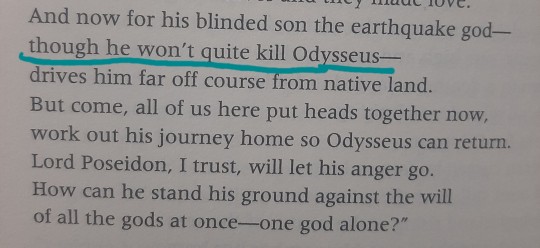
(Od. Book 1: Zeus reassuring Athena that he is not, in fact, a part of Odysseus Hater-Nation. Trans. Robert Fagles)
Also, for those wondering if there's any sort of in text reason for why Poseidon wasn't around in God Games - at the time in the Odyssey when Athena petitions Zeus to let Odysseus leave Calypso's island, Poseidon was -checks notes- on vacation in Ethiopia. Yep. He left to Ethiopia for a festival and thusly was very much absent for Athena's whole "please let Ody go? Please? 🥺" request.
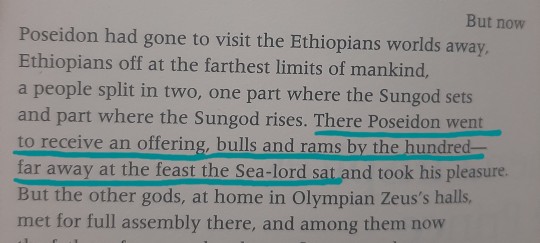
(Od. Book 1: While Odysseus was suffering, Poseidon went to party in the east)
I am begging y'all to read the Odyssey. It's a comedy for everyone except Odysseus and Penelope who are, in fact, suffering 24/7 365.
#ginger rambles#ginger chats about greek myths#Sorry for the quality of the quotes but I'm too tired to google a pdf vers of the Odyssey and then edit those so y'all are getting#my crunchy pictures from one of my physical copies of the book lol#it's reiterated multiple times that Poseidon doesn't want Odysseus dead too#he is literally just driving him mad on the ocean because that's what Odysseus condemned Polyphemus to by blinding him#Also there's no good way to mention this but the Odyssey starts#by Zeus lamenting how mortals blame all their troubles and miseries on the gods when that's just not fair#because the gods go out of their way to warn the mortals that will be saddled with the most wretched fates#and they ignore the gods and do whatever they want anyway LMFAO#It's a really smart way to tie in the whole Orestes plot that would have wrapped up in between Odysseus getting stranded on Ogygia#and Odysseus getting off of Ogygia#epic the musical#epic the wisdom saga#zeus#athena#odysseus#poseidon#the odyssey
4K notes
·
View notes
Text
Wade: *giggling over the fact Logan uses pet names for him*
Logan: Holy shit, I need to find out this guy’s name. I can’t keep calling him Bub….
#BTW HE KNOWS HIS NAME IS WADE WHEN THEY FALL OK THE KIA CARNIVAL#(edit: he actually learns his name in the cage car ride while Johnny is ranting… unless he was trying to block them out)#But before that he literally doesn’t and NO ONE calls Wade Wade#it just is so much funnier from Logan’s perspective#this whole movie#deadpool and wolverine#wolverine#deadpool#poolverine
5K notes
·
View notes
Text

my friends and i watched the parkour movies in one sitting-
#turns out we are not immune to parkour. instant fixation#emf my beloved !!! he’s literally just a void guy with a crown but he has so many design possibilities augh#the gender ever#parkour civilization#parkciv#mcyt#evbo#emf#evbo’s master friend#my doodles#sopuuart#edit: those are netherite boots not leather btw!! probably should’ve used greys tho oopsie
3K notes
·
View notes
Text

this is the funniest outcome ever
[Image description: digital art of Bill Cipher, tangled up in electrical wires. He has a nervous expression, as he holds up a ripped wire and says: "Oops!" There's a glitchy effect behind him. End ID.]
#LMAAAAAAAO#gravity falls#bill cipher#the book of bill#the book of bill spoilers#oh! context just in case: its literally just technical difficulties all thats left to do is just wait patiently#remember to drink water! and walk! and stretch and eat! and breath! your body needs it!#i need it!#edit: thank you to anistarrose for the id! and of reminding me that i gotta start getting on them more
5K notes
·
View notes
Text
What does life in North Korea look like outside of Pyongyang? 🇰🇵
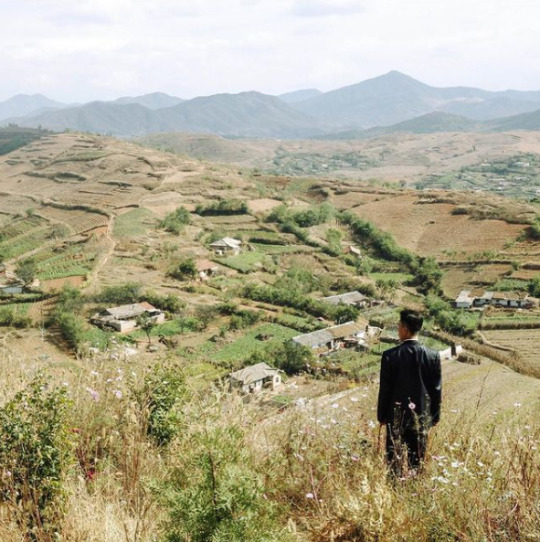
Hey, I'm back again with a very scary "tankie" post that asks you to think of North Koreans as people, and to consider their country not as a cartoonish dystopia, but as a nation that, like any other place on earth, has culture, traditions, and history.
Below is a collection of pictures from various cities and places in North Korea, along with a brief dive into some of the historical events that informs life in the so-called "hermit kingdom."
Warning: very long post
Kaesong, the historic city
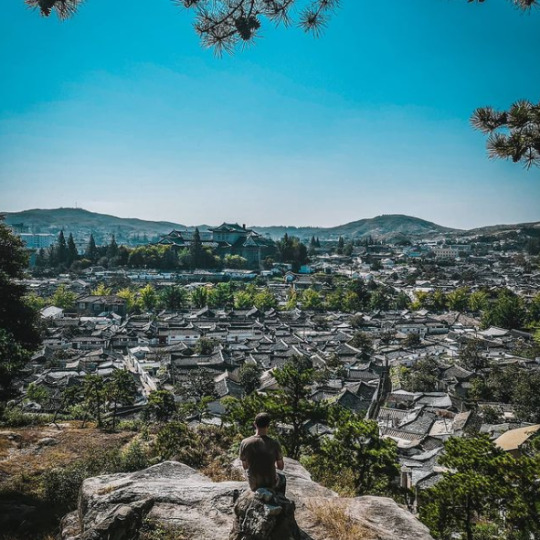
Beginning this post with Kaesong, one of the oldest cities in Korea. It's also one of the few major cities in the DPRK (i.e. "North Korea") that was not completely destroyed during the Korean war.
Every single city you'll see from this point on were victims of intense aerial bombardments from the U.S. and its allies, and had to be either partially or completely rebuilt after the war.
From 1951 to 1953, during what has now become known as the "forgotten war" in the West, the U.S. dropped 635,000 tons of bombs over Korea — most of it in the North, and on civilian population centers. An additional 32,000 tons of napalm was also deployed, engulfing whole cities in fire and inflicting people with horrific burns:
For such a simple thing to make, napalm had horrific human consequences. A bit of liquid fire, a sort of jellied gasoline, napalm clung to human skin on contact and melted off the flesh. Witnesses to napalm's impact described eyelids so burned they could not be shut and flesh that looked like "swollen, raw meat." - PBS
Ever wondered why North Koreans seem to hate the U.S so much? Well...
Keep in mind that only a few years prior to this, the U.S. had, as the first and only country in the world, used the atomic bomb as a weapon of war. Consider, too, the proximity between Japan and Korea — both geographically and as an "Other" in the Western imagination.
As the war dragged on, and it became clear the U.S. and its allies would not "win" in any conventional sense, the fear that the U.S. would resort to nuclear weapons again loomed large, adding another frightening dimension to the war that can probably go a long way in explaining the DPRK's later obsession with acquiring their own nuclear bomb.
But even without the use of nuclear weapons, the indiscriminate attack on civilians, particularly from U.S. saturation bombings, was still horrific:
"The number of Korean dead, injured or missing by war’s end approached three million, ten percent of the overall population. The majority of those killed were in the North, which had half of the population of the South; although the DPRK does not have official figures, possibly twelve to fifteen percent of the population was killed in the war, a figure close to or surpassing the proportion of Soviet citizens killed in World War II" - Charles K. Armstrong
On top of the loss of life, there's also the material damage. By the end of the war, the U.S. Air Force had, by its own estimations, destroyed somewhere around 85% of all buildings in the DPRK, leaving most cities in complete ruin. There are even stories of U.S. bombers dropping their loads into the ocean because they couldn't find any visible targets to bomb.
What you'll see below of Kaesong, then, provides both a rare glimpse of what life in North Korea looked like before the war, and a reminder of what was destroyed.
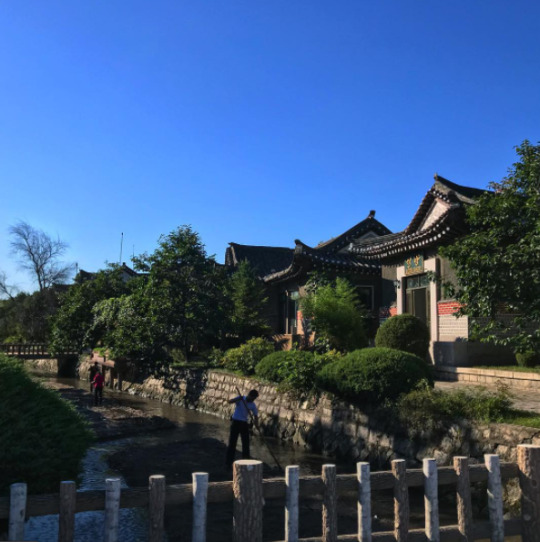
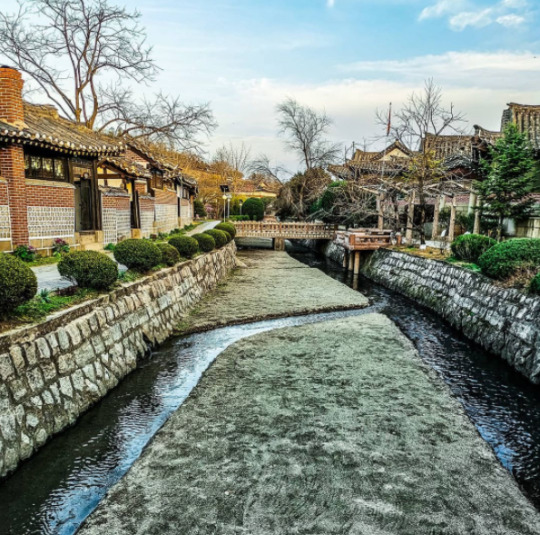
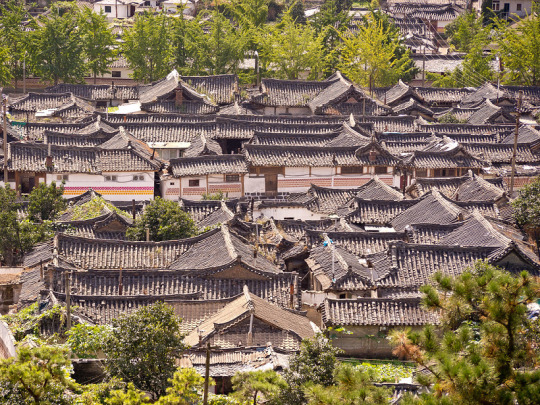
Kaesong's main street, pictured below.
Due the stifling sanctions imposed on the DPRK—which has, in various forms and intensities, been in effect since the 1950s—car ownership is still low throughout the country, with most people getting around either by walking or biking, or by bus or train for longer distances.
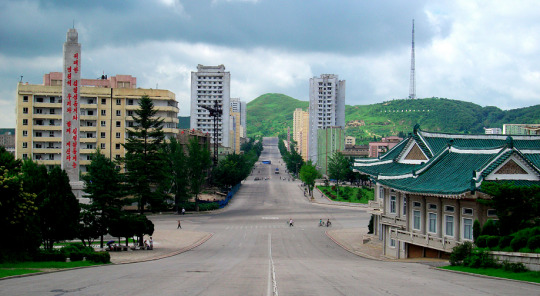
Kaesong, which is regarded as an educational center, is also notable for its many Koryŏ-era monuments. A group of twelve such sites were granted UNESCO world heritage status in 2013.
Included is the Hyonjongnung Royal Tomb, a 14th-century mausoleum located just outside the city of Kaesong.
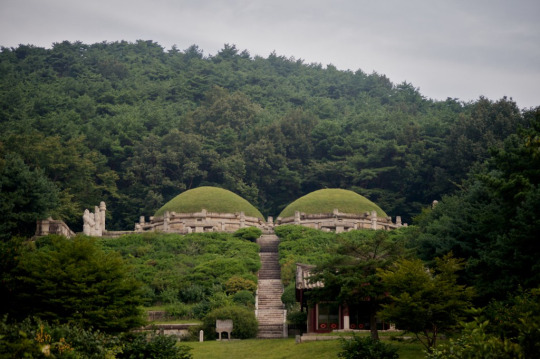
One of the statues guarding the tomb.

Before moving on the other cities, I also wanted to showcase one more of the DPRK's historical sites: Pohyonsa, a thousand-year-old Buddhist temple complex located in the Myohyang Mountains.
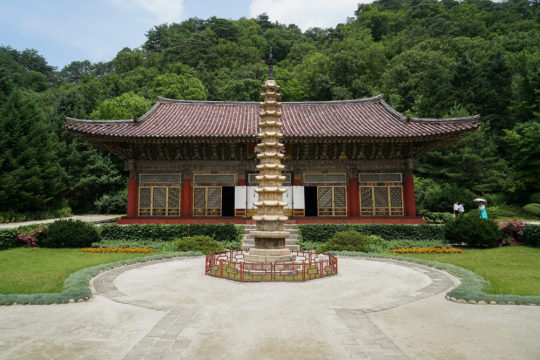
Like many of DPRK's historic sites, the temple complex suffered extensive damage during the Korean war, with the U.S. led bombings destroying over half of its 24 pre-war buildings.
The complex has since been restored and is in use today both as a residence for Buddhist monks, and as a historic site open to visitors.


Hamhung, the second largest city in the DPRK.
A coastal city located in the South Hamgyŏng Province. It has long served as a major industrial hub in the DPRK, and has one of the largest and busiest ports in the country.
Hamhung, like most of the coastal cities in the DPRK, was hit particularly hard during the war. Through relentless aerial bombardments, the US and its allies destroyed somewhere around 80-90% percent of all buildings, roads, and other infrastructure in the city.
Now, more than seventy years later, unexploded bombs, mortars and pieces of live ammunition are still being unearthed by the thousands in the area. As recently as 2016, one of North Korea's bomb squads—there's one in every province, faced with the same cleanup task—retrieved 370 unexploded mortar rounds... from an elementary school playground.
Experts in the DPRK estimate it will probably take over a hundred years to clean up all the unexploded ordnance—and that's just in and around Hamhung.
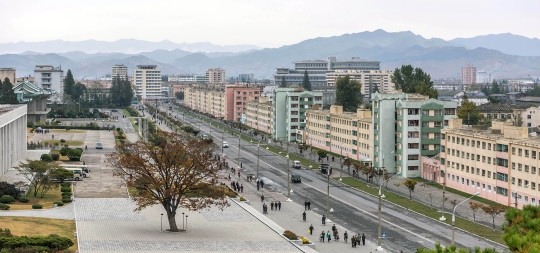
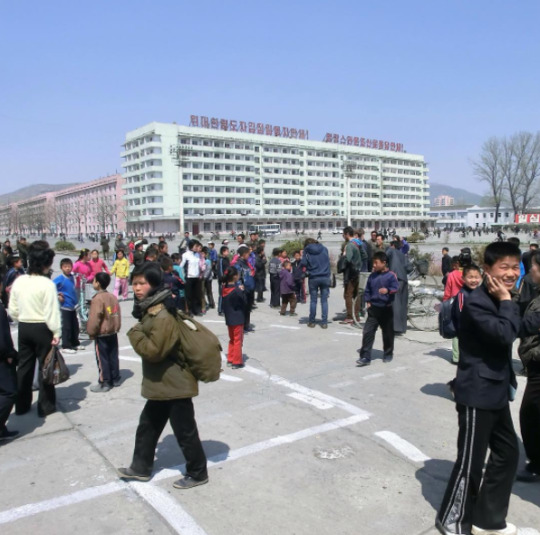
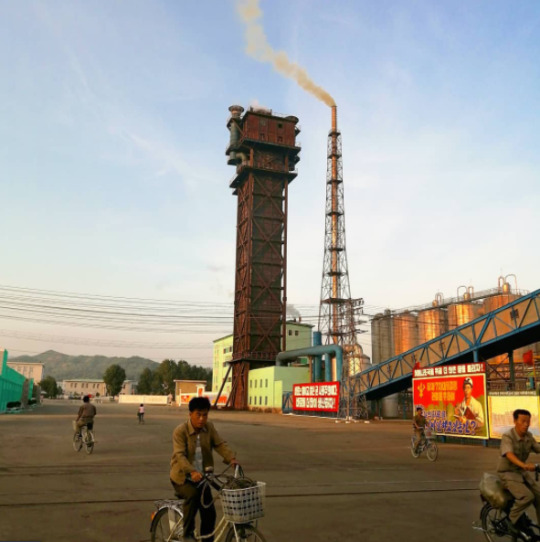
Hamhung's fertilizer plant, the biggest in North Korea.
When the war broke out, Hamhung was home to the largest nitrogen fertilizer plant in Asia. Since its product could be used in the creation of explosives, the existence of the plant is considered to have made Hamhung a target for U.S. aggression (though it's worth repeating that the U.S. carried out saturation bombings of most population centers in the country, irrespective of any so-called 'military value').
The plant was immediately rebuilt after the war, and—beyond its practical use—serves now as a monument of resistance to U.S. imperialism, and as a functional and symbolic site of self-reliance.
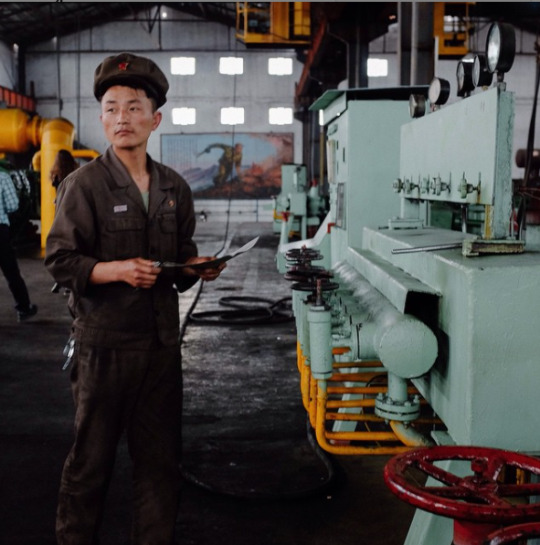
Chongjin, the third largest city in the DPRK.
Another coastal city and industrial hub. It underwent a massive development prior to the Korean war, housing around 300,000 people by the time the war broke out.
By 1953, the U.S. had destroyed most of Chongjin's industry, bombed its harbors, and killed one third of the population.
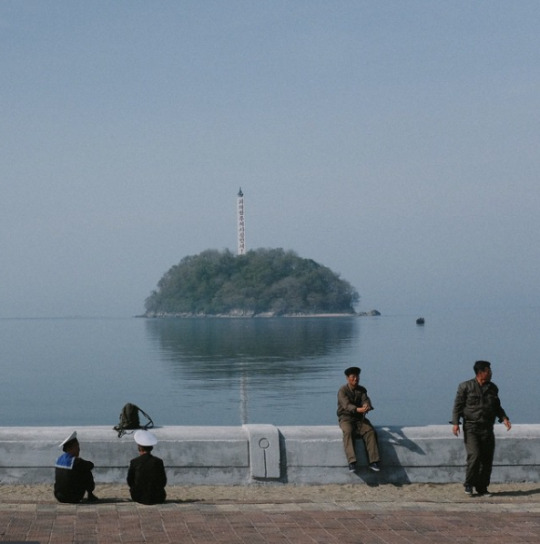


Wonsan, a rebuilt seaside city.
The city of Wonsan is a vital link between the DPRK's east and west coasts, and acts today as both a popular holiday destination for North Koreans, and as a central location for the country's growing tourism industry.
Considered a strategically important location during the war, Wonsan is notable for having endured one of the longest naval blockades in modern history, lasting a total of 861 days.
By the end of the war, the U.S. estimated that they had destroyed around 80% of the city.
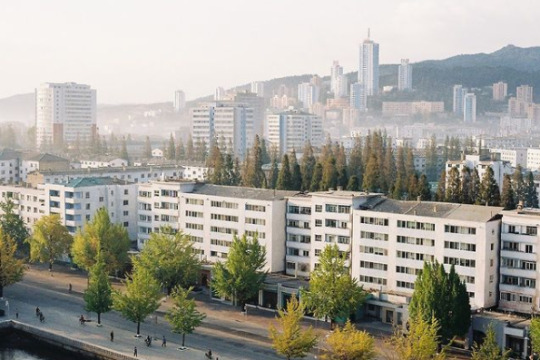
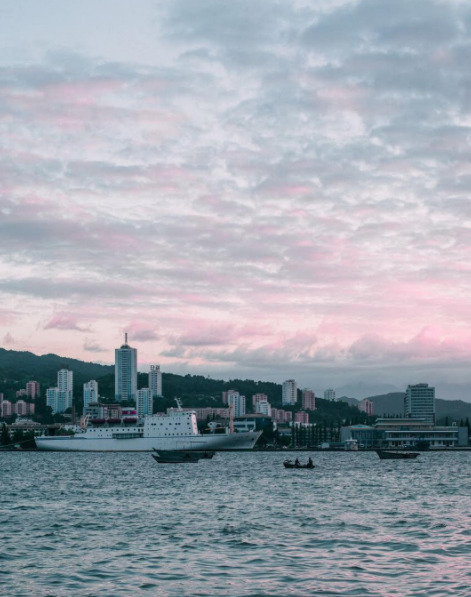
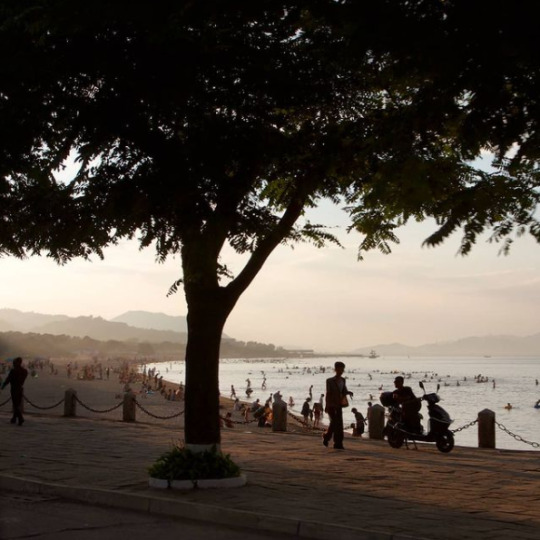
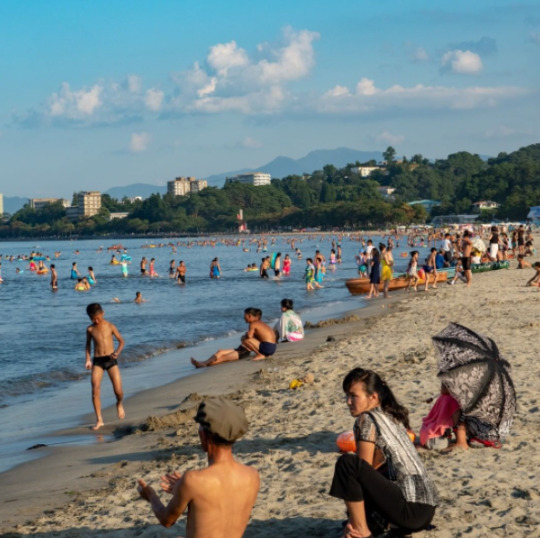
Masikryong Ski Resort, located close to Wonsan. It opened to the public in 2014 and is the first, I believe, that was built with foreign tourists in mind.
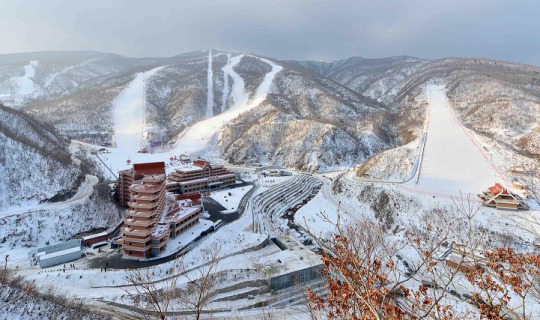
Sariwon, another rebuilt city
One of the worst hit cities during the Korean War, with an estimated destruction level of 95%.
I've written about its Wikipedia page here before, which used to mockingly describe its 'folk customs street'—a project built to preserve old Korean traditions and customs—as an "inaccurate romanticized recreation of an ancient Korean street."
No mention, of course, of the destruction caused by the US-led aerial bombings, or any historical context at all that could possibly even hint at why the preservation of old traditions might be particularly important for the city.
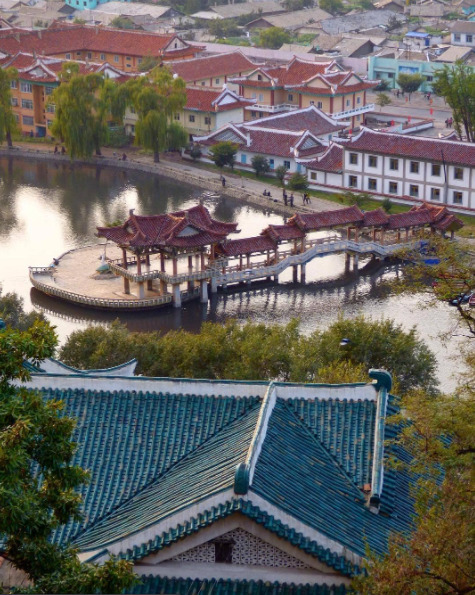

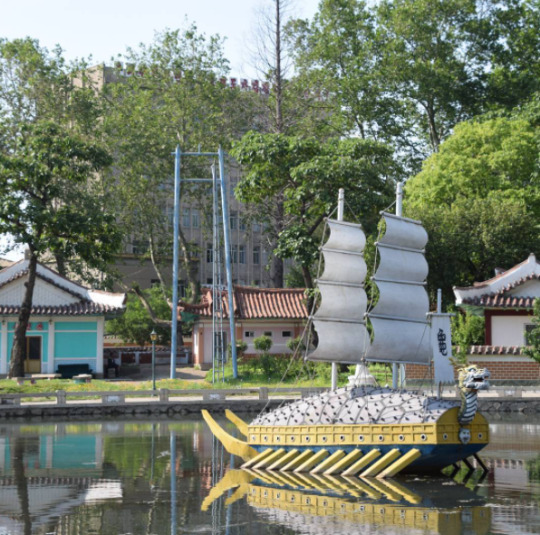
Life outside of the towns and cities
In the rural parts of the DPRK, life primarily revolves around agriculture. As the sanctions they're under make it difficult to acquire fuel, farming in the DPRK relies heavily on manual labour, which again, to avoid food shortages, requires that a large portion of the labour force resides in the countryside.
Unlike what many may think, the reliance on manual labour in farming is a relatively "new" development. Up until the crisis of the 1990s, the DPRK was a highly industrialized nation, with a modernized agricultural system and a high urbanization rate. But, as the access to cheap fuel from the USSR and China disappeared, and the sanctions placed upon them by Western nations heavily restricted their ability to import fuel from other sources, having a fuel-dependent agricultural industry became a recipe for disaster, and required an immediate and brutal restructuring.
For a more detailed breakdown of what lead to the crisis in the 90s, and how it reshaped the DPRKs approach to agriculture, check out this article by Zhun Xu.

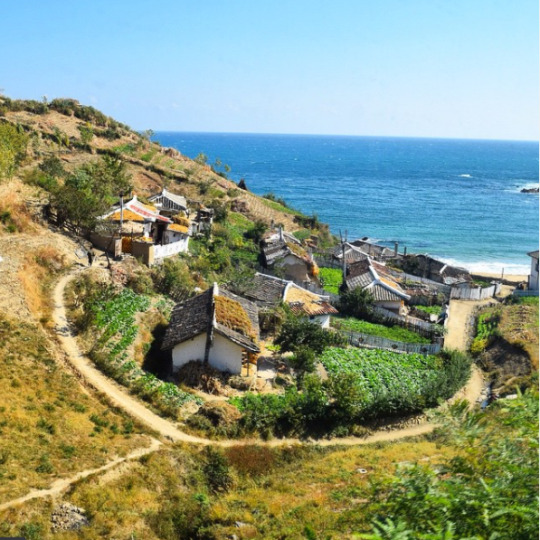
Some typical newly built rural housing, surrounded by farmland.
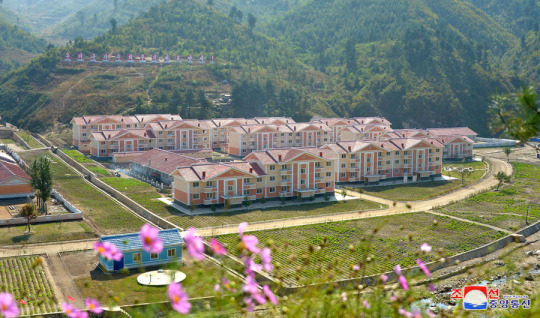
Tumblr only allows 20 pictures per post, but if you want to see more pictures of life outside Pyongyang, check out this imgur album.
#dprk#north korea#i've had this post unfinished in drafts for almost a year#also sorry about the spelling and potential formatting issues it's a nightmare to edit at this point#it was literally just meant to be a collection of picture and then the writing just sort of happened#enjoy the brief heritageposts history lesson i guess
7K notes
·
View notes
Text







The ten hours I spent with that boy were more exciting, more fascinating, than decades with you!
#still thinking about how louis literally threw his childhood trauma in his face but being called boring is what sent him over the edge#armand#interview with the vampire#iwtvedit#edits
3K notes
·
View notes
Text
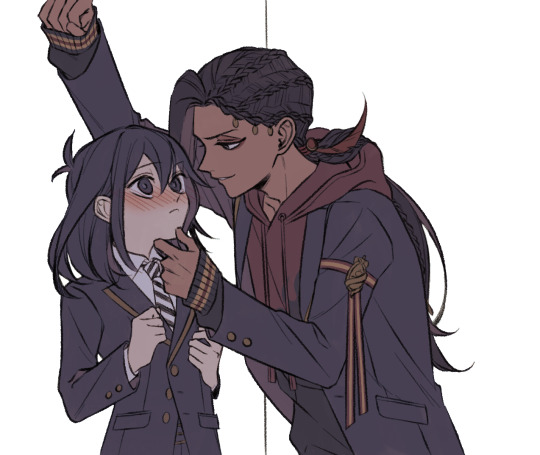
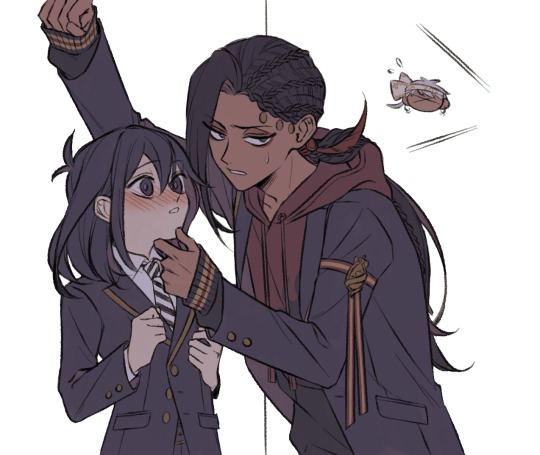
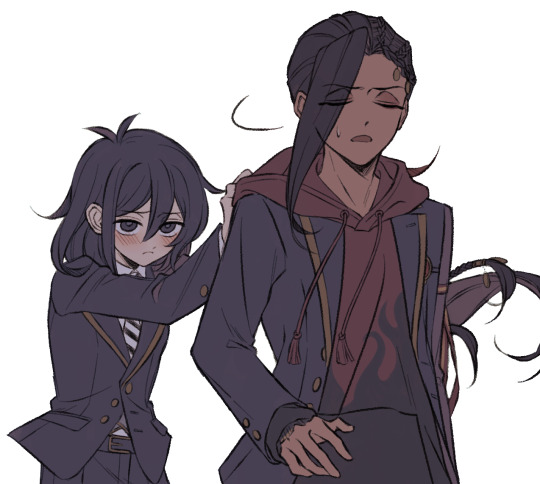
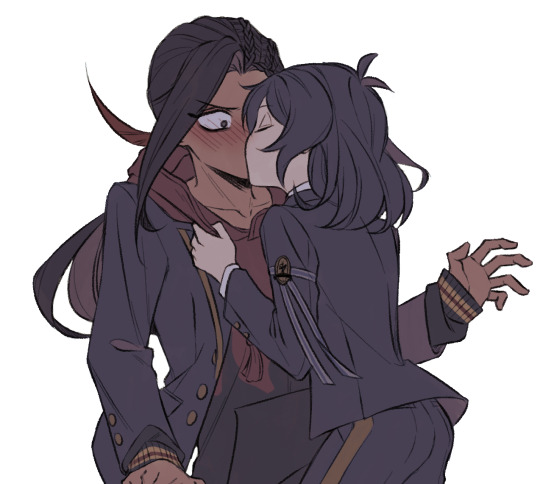
"(Sigh) We'll continue this another ti- mmf?!"
With a guy like Jamil, you really gotta pick up the slack sometimes. No tie to pull on though, so I guess we'll just have to use that hoodie!
(Inspired by this artwork by オレコ on Pixiv!)
Bonus Jamil for the rest of the day:
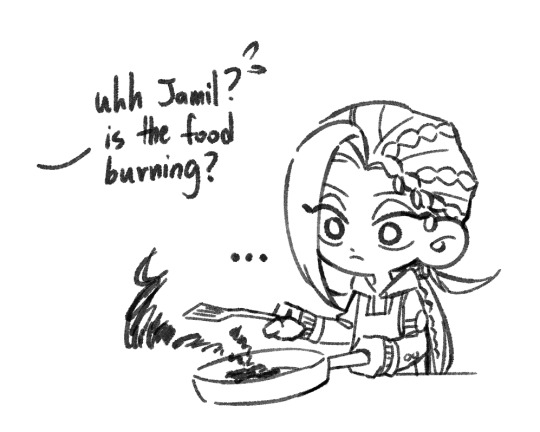
#my art#twisted wonderland#twst#jamil viper#jamil viper x yuu#oc#twst oc#shiokawa mayu#jamimayu#this was well worth losing sleep for#when i say i locked in#ill probably add more tags later when i wake up but like#the moment i remembered that set of images existed the other day#i was like#wait thats them#i gotta redraw#cue a few days of me drawing basically nothing but this#enjoy their first proper kiss#and kabedon ig#girls who look shy but are actually really forward my beloved#if its not obvious she's pulling him downward in the last pic#gotta compensate for that height diff u see#edit: forgot his eye makeup in the last one literally unviewable#and some other small fixes
2K notes
·
View notes